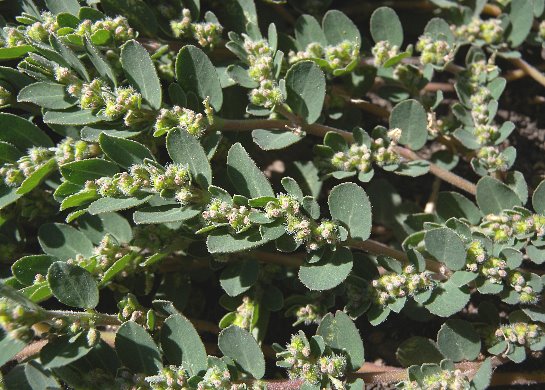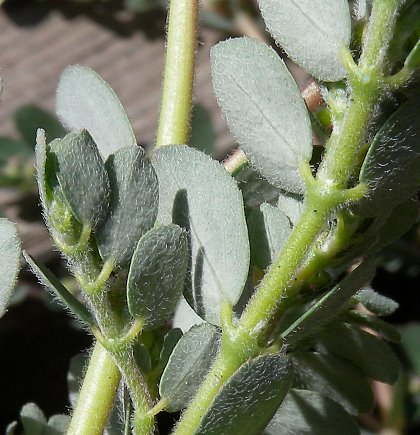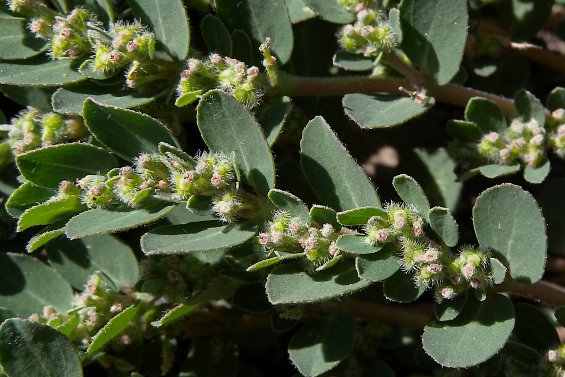
Small clusters of 1-4 inflorescences develop from the axils of each pair of leaves. Each inflorescence is about 2 mm. across, consisting of a cup-like cyathium on a short stalk that contains a single pistillate flower on a short stalk and 4 staminate flowers. Each cyathium is light green and glabrous to slightly hairy; there are 4 red nectar glands with whitish petaloid appendages along the upper rim of each cyathium. The pistillate flower consists of a 3-lobed ovary with a divided style at its apex; the ovary is light green (while immature), ovoid-globoid in shape, and its lobes have spreading hairs. The stalk of the pistillate flower curves sideways or downward initially, but it later becomes erect at maturity. A staminate flower within the inflorescence consists of a single stamen. The blooming period occurs from mid-summer into fall for about 2 months. At maturity, the ovaries develop into 3-celled seed capsules; each cell of a capsule contains a single seed. The seeds are distributed, in part, by mechanical ejection. Individual seeds are about 1.0 mm. in length, oblongoid-rectangular in shape, and transversely ridged. The root system consists of a slender taproot that branches. The foliage of this plant contains a milky latex.
Cultivation: The preference is full to partial sun, dry-mesic to dry conditions, and barren soil containing sand, gravel, or clay. However, Green Creeping Spurge also adapts to soil containing fertile loam if disturbance removes taller ground vegetation. Because of its C4-metabolism and slightly succulent nature, this plant can withstand hot dry conditions.

Range & Habitat: Green Creeping Spurge is a rare plant in Illinois, where it has been accidentally introduced. It has been observed in NE Illinois and more recently in Champaign County (see Distribution Map). These records may underestimate its distribution within the state, however. Green Creeping Spurge is native to tropical America. Habitats include lawns, gardens, areas along railroads and roadsides, areas near parking lots, cracks of urban sidewalks, and barren waste places. Open sunny areas with a history of disturbance are preferred.
Faunal Associations: The nectaries of the flowers attract Syrphid flies, Halictid bees, and various ants (Lasius, Formica, & Forelius spp.). Some bees may also collect pollen. Two aphids suck juices from Chamaesyce spp. (Low Spurges): Macrosiphum euphorbiae and Macrosiphum gei. Other insect feeders include the plant bug, Semium hirtum, and the flea beetle, Glyptina leptosoma. The latter insect feeds on the roots. Because of the toxic white latex and its low stature, mammalian herbivores have little use for Green Creeping Spurge and other Chamaesyce spp. However, the following birds eat the seeds of these plants: Greater Prairie Chicken, Bobwhite, Mourning Dove, Horned Lark, and Chipping Sparrow (Martin et al., 1951/1961). Because of an oily food appendage on each seed (referred to as a 'caruncle'), ants probably play a role in distributing the seeds to new areas.

Photographic Location: Along a parking lot and a railroad in Urbana, Illinois.
Comments: Green Creeping Spurge is a relatively recent invader of Illinois. Because of its low habit and similarity to other Chamaesyce spp. (Low Spurges), this invasion has gone largely unnoticed. At a cursory glance, Green Creeping Spurge resembles a common native species, Prostrate Spurge (Chamaesyce maculata, formerly Chamaesyce supina), and the two species can be found together in the same habitats, particularly in some urban areas. The latter species differs from Green Creeping Spurge as follows: 1) its leaves are about 3 times as long as they are across, rather than 2 times as long as they are across, 2) its leaves often have a patch of dark red in their centers, 3) the lobes of its ovaries/capsules have appressed hairs, rather than spreading hairs, and 4) its mature seed capsules are often found below the leaves on curved stalks, rather than above the leaves on erect stalks. Scientific synonyms of Green Creeping Spurge include Euphorbia prostrata and Euphorbia chamaesyce. Another common name of this species is Prostrate Sandmat.